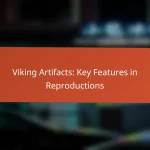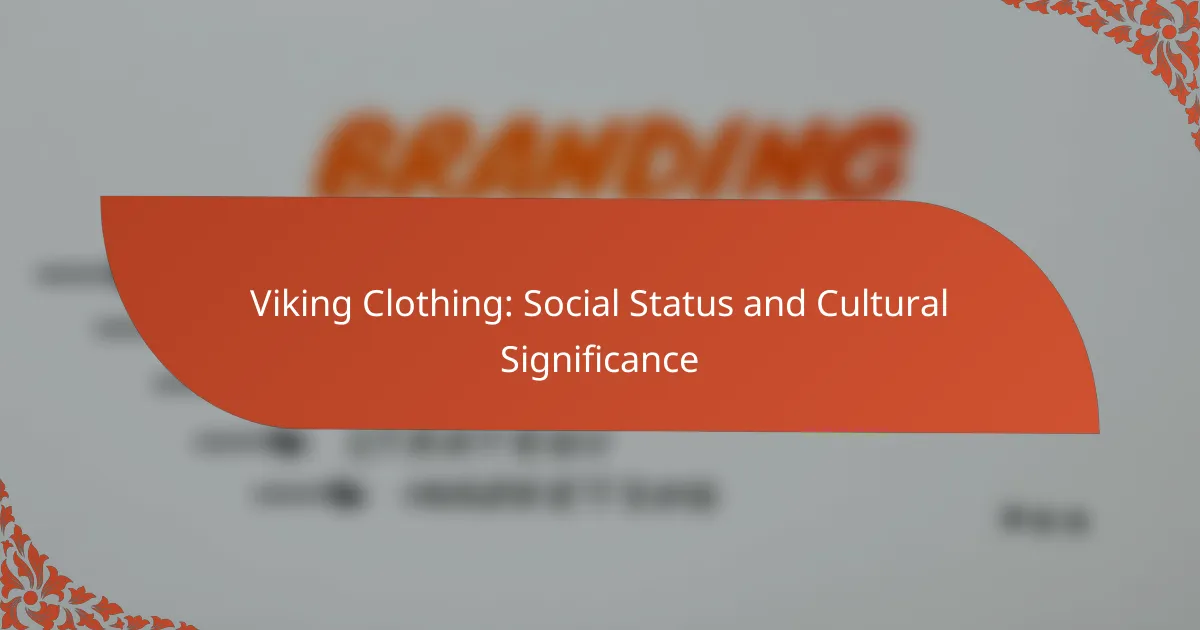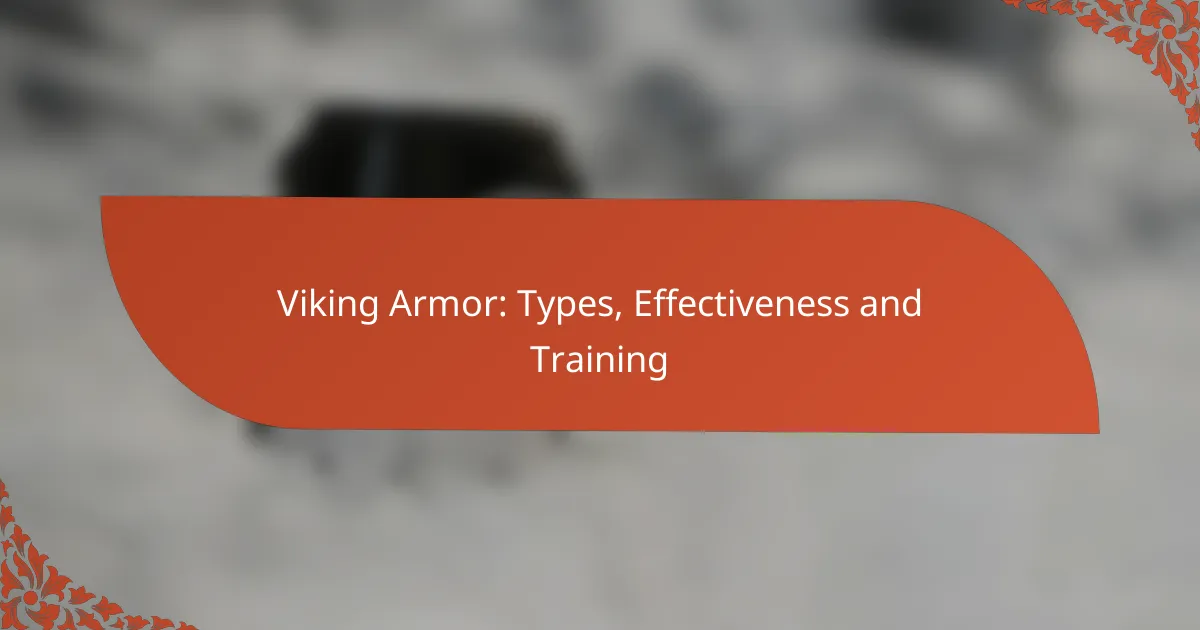Viking clothing trends in modern fashion emphasize sustainability, cultural heritage, and distinctive designs, showcasing a renewed interest in eco-friendly materials and traditional Norse aesthetics. By integrating key pieces like tunics and cloaks into contemporary wardrobes, individuals can celebrate this rich history while maintaining a modern style. Authentic Viking attire is accessible through various channels, ensuring that quality craftsmanship and materials are prioritized for a true representation of this unique fashion heritage.
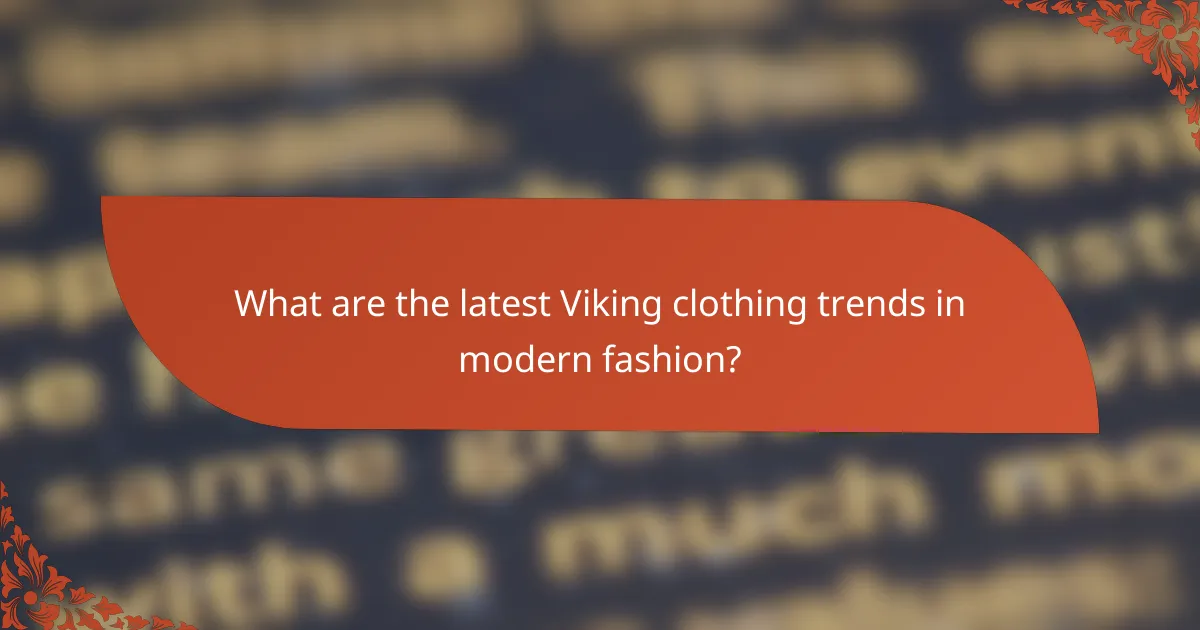
What are the latest Viking clothing trends in modern fashion?
The latest Viking clothing trends in modern fashion focus on sustainability, cultural heritage, and unique designs. These trends reflect a growing interest in eco-friendly materials, traditional Norse aesthetics, and the adaptation of historical garments into contemporary wardrobes.
Emphasis on sustainable materials
Modern Viking-inspired fashion increasingly prioritizes sustainable materials, such as organic cotton, linen, and recycled fibers. Designers aim to reduce environmental impact while maintaining the authenticity of Viking aesthetics.
Consumers are encouraged to look for certifications like GOTS (Global Organic Textile Standard) or OEKO-TEX, which ensure that materials are produced sustainably. This shift not only supports eco-friendly practices but also appeals to a growing demographic that values ethical fashion.
Incorporation of Norse patterns
Norse patterns, including intricate knotwork and runic designs, are becoming prominent in contemporary clothing. These motifs are often featured in prints, embroidery, and woven fabrics, adding a distinct cultural touch to modern garments.
Fashion brands are blending traditional Norse designs with modern silhouettes, creating pieces that resonate with both history enthusiasts and fashion-forward consumers. This integration allows for a unique expression of identity and heritage in everyday wear.
Adaptation of traditional garments
Traditional Viking garments, such as tunics and cloaks, are being reimagined for today’s fashion landscape. Designers are adapting these historical pieces to suit modern tastes while preserving their original essence.
For instance, tunics may be tailored for a more fitted look, and cloaks can be made with lighter, breathable fabrics suitable for various climates. This adaptation makes Viking-inspired clothing more accessible and wearable for daily life.
Influence of Scandinavian design
Scandinavian design principles, characterized by minimalism and functionality, are influencing modern Viking fashion. This approach emphasizes clean lines, practicality, and a harmonious blend of form and function.
Fashion items inspired by this design ethos often feature neutral color palettes and versatile styles that can be easily mixed and matched. This trend not only enhances the aesthetic appeal but also ensures that garments are suitable for a variety of occasions, from casual outings to formal events.

How to integrate Viking clothing into everyday wear?
Integrating Viking clothing into everyday wear involves blending traditional elements with modern fashion. Focus on key pieces like tunics, cloaks, and accessories that can complement your existing wardrobe.
Mixing with contemporary styles
To effectively mix Viking clothing with contemporary styles, start with basic pieces such as a simple tunic or a long vest. Pair these with modern jeans or tailored trousers to create a balanced look that feels both unique and approachable.
Consider using neutral colors for Viking-inspired garments to ensure they blend seamlessly with your current wardrobe. For example, a dark wool cloak can add a historical touch without overwhelming your outfit.
Layering techniques for versatility
Layering is key to making Viking clothing versatile for everyday wear. Start with a fitted base layer, such as a long-sleeve shirt, and add a tunic or a loose-fitting dress over it. This not only adds depth to your outfit but also allows for comfort and warmth.
Experiment with different lengths and textures. For instance, a short tunic over a longer shirt can create an interesting silhouette. Don’t hesitate to mix fabrics like wool and linen to enhance the visual appeal.
Accessorizing with Viking-inspired jewelry
Accessorizing with Viking-inspired jewelry can elevate your outfit and add a personal touch. Look for pieces like brooches, rings, or necklaces that feature Norse symbols or intricate designs. These can serve as conversation starters and highlight your interest in Viking culture.
When choosing jewelry, aim for a balance between bold statement pieces and subtle accents. For example, a large pendant can be paired with simpler clothing, while smaller items can be layered for a more intricate look. Consider the materials as well; silver and bronze are traditional choices that complement Viking aesthetics.

Where to buy authentic Viking clothing?
Authentic Viking clothing can be found through various sources, including online retailers, local craft fairs, and specialized shops. When seeking genuine pieces, consider the quality of materials and craftsmanship to ensure a true representation of Viking attire.
Specialty online retailers
Specialty online retailers are a convenient option for purchasing authentic Viking clothing. Websites like Nordic Threads and Viking Clothing Co. offer a range of garments, from tunics to cloaks, often crafted from natural fibers like wool and linen. Look for retailers that provide detailed descriptions and customer reviews to gauge authenticity.
When shopping online, check for return policies and shipping costs, especially if ordering from international sites. Many retailers offer free shipping over a certain amount, which can help save on costs.
Local craft fairs in Nordic regions
Local craft fairs in Nordic regions are excellent venues for finding authentic Viking clothing. These events often feature artisans who specialize in historical garments, allowing you to purchase directly from the makers. Look for fairs in countries like Sweden, Norway, and Denmark, where traditional crafts are celebrated.
Visiting these fairs not only supports local craftsmen but also provides an opportunity to see and feel the materials used in the clothing. Engaging with the artisans can also lead to custom orders tailored to your preferences.
Historical reenactment shops
Historical reenactment shops cater specifically to those interested in Viking culture and clothing. These shops typically offer a variety of garments and accessories that are historically accurate, making them a reliable source for enthusiasts. Check for shops that participate in reenactment events, as they often have a deeper understanding of authenticity.
When shopping at these stores, inquire about the materials and construction techniques used. Many shops also provide guidance on how to properly care for and wear the garments, ensuring you maintain their quality over time.
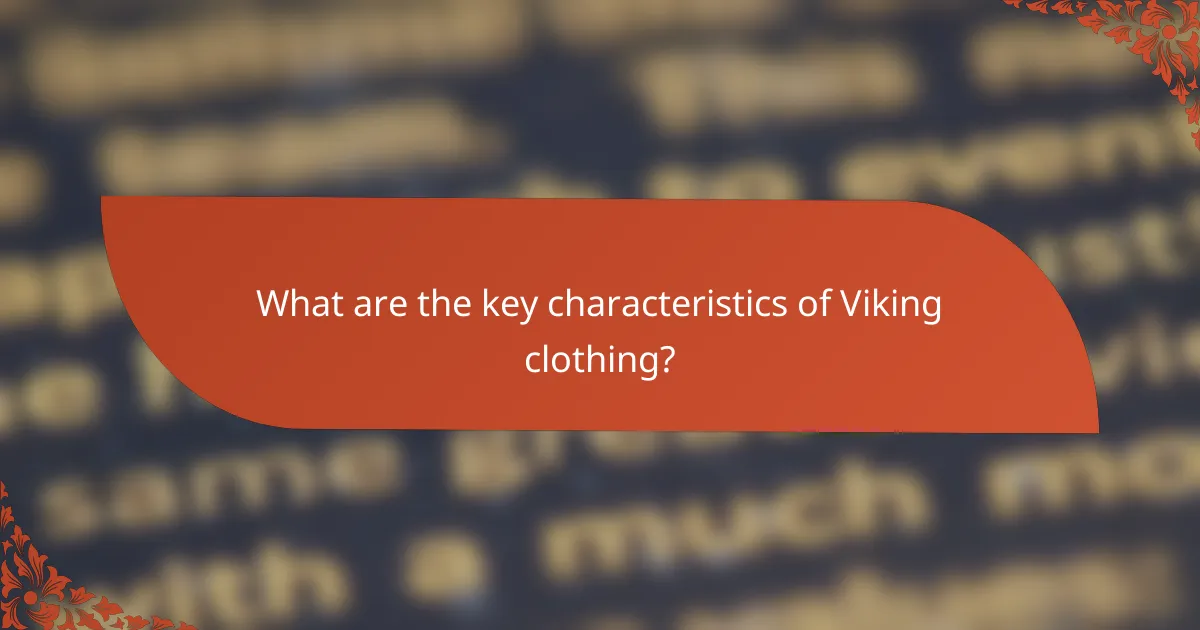
What are the key characteristics of Viking clothing?
Viking clothing is characterized by its use of natural materials, practical designs, and vibrant colors. These elements reflect the lifestyle and environment of the Norse people, emphasizing functionality and durability.
Use of natural fibers
Viking clothing primarily utilized natural fibers such as wool, linen, and animal hides. Wool was favored for its warmth and water resistance, while linen provided breathability during warmer months. Animal hides were often used for outer garments and footwear, offering protection against harsh weather.
When selecting fabrics, consider the climate and activities. For colder regions, thicker wool garments are advisable, while lighter linen can be suitable for milder conditions. Look for high-quality, untreated fibers to ensure longevity and comfort.
Functional design for mobility
The design of Viking clothing prioritized mobility and practicality. Garments were often loose-fitting to allow for ease of movement, essential for daily tasks and combat. Features such as tunics, trousers, and cloaks were common, with many items designed to be layered for warmth.
When creating or choosing Viking-inspired clothing, focus on functional cuts and adjustable elements like belts or ties. This ensures comfort and versatility, making it suitable for various activities, from farming to sailing.
Distinctive color palettes
Viking clothing showcased distinctive color palettes, often achieved through natural dyes from plants, minerals, and insects. Common colors included deep reds, blues, greens, and yellows, reflecting both personal style and social status. Brightly colored garments were often worn during festivals and important events.
To replicate Viking color schemes, consider using natural dyes or fabrics dyed with traditional methods. This not only enhances authenticity but also connects with the historical significance of color in Viking culture. Aim for bold combinations that reflect the vibrancy of the era.

How does Viking clothing reflect cultural heritage?
Viking clothing serves as a vivid representation of their cultural heritage, showcasing their values, social status, and regional identity. The materials, designs, and techniques used in their garments reveal insights into their daily lives and the significance they placed on craftsmanship.
Symbolism in patterns and colors
Patterns and colors in Viking clothing often held deep symbolic meanings. For instance, bright hues like red and blue were associated with strength and valor, while earthy tones represented connection to the land. Specific patterns, such as braids and knots, were not only decorative but also conveyed messages about the wearer’s lineage or status.
Additionally, certain colors were reserved for specific occasions or social classes. Wealthier individuals might wear garments adorned with intricate embroidery, while common folk typically opted for simpler designs. This differentiation in clothing reflected the societal hierarchy within Viking communities.
Historical significance of garments
The historical significance of Viking garments extends beyond mere aesthetics; they were practical and functional for the harsh climates of Scandinavia. Clothing was made from wool, linen, and animal hides, providing warmth and durability. The construction techniques, such as the use of the tablet weaving method, highlight the advanced textile skills of the Vikings.
Moreover, garments often indicated a person’s role within the community. For example, warriors donned specific attire to signify their readiness for battle, while women wore distinct styles that reflected their roles in family and society. Understanding these historical garments allows for a deeper appreciation of Viking culture and its lasting influence on modern fashion.





